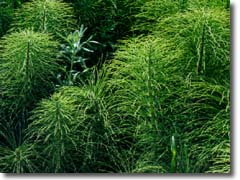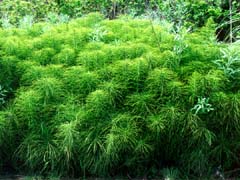Equisteraceae (Horsetail Family)

Equisteraceae is a family of "Fern Allies"; in that they have life cycles similar to ferns (see Fern Characteristics), no flowers, but have cones like gymnopserms (firs and pines) and seeds. They are also more diverse in their form than ferns.
The visible parts of members of Equisteraceae sprout from a series of underground stems. The surface of the plant contains silica and may have projections of the material that give them a harsh, gritty (scouring) surface. So much so, they were once used for scouring pots and pans.
In general, they favor wet areas, usually found along creeks and seeps. On Montara Mountain, we can find Equisetum hypemale ssp. affine - (Western Scouring Rush) and Equisetum telmateia ssp. braunii - (Giant Horsetail).

